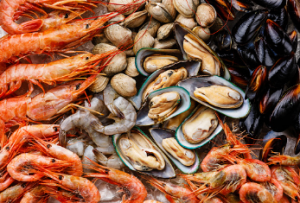Frozen seafood can be an incredibly convenient option to keep in your refrigerator. It’s also straightforward to prepare, so you can have a tasty, fresh meal even when tight. First, however, you should keep a few things in mind if you want to know more about frozen seafood.
 Odour in frozen seafood
Odour in frozen seafood
There are several issues surrounding odour in ShoreMarinerNZ frozen seafood. While it is impossible to assess the quality of such items fully, you can learn what to look for. If you suspect smell, you should inspect the packaging for any signs of rough handling, bruising, or air ingress. You can also use lemon juice to neutralise the odour if desired. It leaves the fish with a citrusy flavour.
While many consumers may prefer frozen seafood over fresh, some concerns about its safety and quality exist. Some may discard it because of the preservatives used in freezing or the lack of palatability. Other consumers may be apprehensive about the risk of bacterial contamination, which is transferred from raw fish to cooked or ready-to-eat fish.
To combat these issues, the Drexel Food Lab developed a recipe that is tested with consumers. The goal was to find a way to promote the safe and tasty cooking of frozen seafood. A marketing campaign and educational outreach can also address the barriers to cooking direct from the freezer.
Another study examined the perceptions of consumers regarding frozen seafood. Data were collected from a consumer diary survey and focus groups, and several of the focus group participants expressed their preference for fresh seafood. In addition, the focus groups provided the researchers with an understanding of the various factors influencing a consumer’s seafood choice.
The study found that most consumers prefer to eat fresh seafood. It may be due to a high familiarity with the product or a concern about the quality of frozen seafood. However, low cleanliness or carelessness can also lead to unnecessary discards.
Nutritional value
There are several health benefits associated with eating seafood. For example, it helps prevent asthma and vision problems in old age. It is also suitable for the environment. In addition, it can help you adhere to current dietary recommendations. You can get your recommended intake of nutrients by eating seafood twice a week.
Fish are rich in vitamin B. They are also rich in protein. It makes them easier to digest. Their amino acids are all essential. Additionally, they have less connective tissue than meat. Moreover, they help fight the symptoms of Type 1 diabetes.
Frozen fish is also better for the environment. Compared to fresh fish, ShoreMarinerNZ frozen seafood can last many more months. Therefore, buying frozen foods can save you money and reduce waste. However, they are less healthy than their fresh counterparts. Therefore, choosing only the highest quality products is a good idea. Some of the best choices include canned tuna, salmon and sardines.
It’s also worth noting that fish is an excellent source of omega-3 fatty acids. It’s also important to note that freezing doesn’t destroy these fatty acids. The flash-freezing process also protects the fish’s fat structures.
While it’s true that fish has several nutritional properties, comparing the nutritional value of frozen and fresh products is difficult. Nevertheless, the nutritional value of frozen fish is better than fresh fish. It’s also wise to buy from a reputable organisation like Monterey Bay Aquarium’s Seafood Watch. Also, check the label to ensure that the product is fresh. Otherwise, you’re wasting your money. Ultimately, deciding which type of seafood you will eat is up to you.
Flavour and texture
Before you purchase a particular type of frozen seafood, take a few minutes to evaluate its appearance, smell, and texture. If you need clarification on the quality of the product, check its packaging. Make sure the container is airtight, so it can’t leak. Also, the fillets should be free of discolouration, spots, or ice crystals.
Frozen seafood can be a convenient way to store fish since it won’t spoil quickly. However, it’s essential to keep it at a low temperature. Low temperatures help preserve the taste and texture of the food while extending its shelf life. Therefore, it’s essential to know the signs of freezer burn.
Less wasteful than fresh
Seafood waste is a significant issue. The United Nations estimates that 35 per cent of the harvested seafood is later lost. It represents a loss of high-value nutritious food. It also has environmental impacts. A growing body of research examines consumer attitudes and behaviours associated with food waste. We can develop interventions to prevent waste by understanding the consumer’s attitudes towards seafood.
There are many reasons why consumers waste seafood. Many of these reasons have to do with perishability or quality. However, some consumers also consider frozen fish to be lower in quality. Other factors include carelessness and common standards.
The researchers found that the average household wastes about 10% of the seafood it purchases. Some consumers report that they are embarrassed by the waste they produce. Others claim that they waste less than the average American. However, the study does not offer any definitive answers.
The researchers conducted a comprehensive survey to better understand consumer attitudes and seafood behaviour. They also conducted focus groups. Their findings revealed that most participants attributed their attitudes about food waste to family values. Moreover, participants characterised their attitudes about seafood waste as embedded in their identities.
Using a new concept model, the researchers outlined various potential factors contributing to seafood waste. They found that unavoidability, planning, and perishability were the most common factors leading to discards.
Despite these significant drivers, the study found that consumer attitudes toward seafood waste differ from those of other foods. These attitudes suggest that specific food groups have different consumer waste profiles, and these factors can provide insights into seafood-specific consumer food waste intervention approaches.